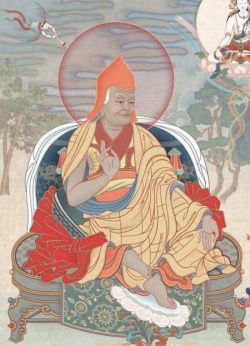Jamgon Kongtrul, Lodro Thaye
- See also :
- See also :
Jamgon Lodro Thaye is considered an emanation of the great translator Vairotsana who, in turn, was regarded as an emanation of Buddha Vairochana.
The three masters - Chokgyur, Khyentse and Kongtrul - were connected to each other as 'mingled minds'. They were both teachers and disciples of one another.Chokgyur Lingpa regarded both Khyentse and Kongtrul as his teachers. However since Jamyang Khyentse Wangpo received the entire Tersar transmission from Chokgyur Lingpa, Chokgyur Lingpa can be considered as one of his teachers. Without question, Kongtrul accepted both Jamyang Khyentse Wangpo and Chokgyur Lingpa as his masters.
Khyentse and Chokling had received a prediction [from Padmasambhava) stating, "You possess the karmic continuity of being linked as father and son." The father was Jamyang Khyentse Wangpo and the son Chokgyur Lingpa. Their minds mingled into oneness - meaning they had an identical level of experience and realization - like the torrential rivers of summer. That is the metaphor for their meeting, exchanging pith instructions and awakening their full karmic potential.
Jamgon Kongtrul was enthroned by the other two as the authentic incarnation, the conscious rebirth, of Lotsawa Vairotsana. In this way, they assisted each other so that their mutual benefit for the Buddhadharma and all beings was similar to the sun rising in the sky.
When Samye was under construction, Guru Rinpoche, Vimalamitra, Buddhaguhya Buddhaguhya and other great masters, along with their chief disciples such as Vairotsana and Yudra Nyingpo, all helped the teachings of the Buddha to flourish like the sun rising at dawn. At the end of this period of the Dharma, these masters returned in the form of Khyentse, Kongtrul and Chokling. In fact, during that time in the Nangchen and Derge provinces of Kham, as well as in Ü and Tsang of Central Tibet, tulkus of all 25 of Padmasambhava's close disciples were identified and recognized. Once Dzongsar Khyentse Rinpoche told me, "The twenty-five disciples all appeared together, like a flock of sheep and goats running out of a barn. This was a portent that the time for Tibet's role as a 'field of conversion' for beings was just about to come to a close. Just like when these 25 disciples assembled at Samye in the early times, during the time of Khyentse, Kongtrul and Chokling, again these masters all returned in person. These 25 disciples appeared as masters with incredible experience and realization, learning and accomplishment. Their personal disciples and grand-disciples were equally amazing." That is what Dzongsar Khyentse told me about the simultaneous return of these three great masters.
Also known as Lodro Thaye, Yonten Gyamtso, Padma Garwang and by his terton name Padma Tennyi Yungdrung Lingpa. He was one of the most prominent Buddhist masters in the 19th century and placed special focus upon a non-sectarian attitude. Renowned as an accomplished master, scholar and writer, he authored more than 100 volumes of scriptures. The most well known are his Five Treasuries, among which are the 63 volumes of the Rinchen Terdzo, the terma literature of the one hundred great tertons.
